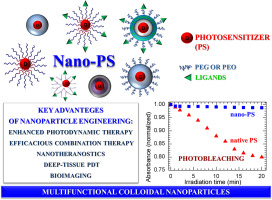Advances in Colloid and Interface Science ( IF 15.9 ) Pub Date : 2018-09-18 , DOI: 10.1016/j.cis.2018.09.002 Łukasz Lamch , Agata Pucek , Julita Kulbacka , Michał Chudy , Elżbieta Jastrzębska , Katarzyna Tokarska , Magdalena Bułka , Zbigniew Brzózka , Kazimiera A. Wilk

|
This up-to-date review summarizes the design and current fabrication strategies that have been employed in the area of mono- and multifunctional colloidal nanoparticles – nanocarriers well suited for photodynamic therapy (PDT) and diagnostic purposes. Rationally engineered photosensitizer (PS)-loaded nanoparticles may be achieved via either noncovalent (i.e., self-aggregation, interfacial deposition, interfacial polymerization, or core-shell entrapment along with physical adsorption) or covalent (chemical immobilization or conjugation) processes. These PS loading approaches should provide chemical and physical stability to PS payloads. Their hydrophilic surfaces, capable of appreciable surface interactions with biological systems, can be further modified using functional groups (stealth effect) to achieve prolonged circulation in the body after administration and/or grafted by targeting agents (such as ligands, which bind to specific receptors uniquely expressed on the cell surface) or stimuli (e.g., pH, temperature, and light)-responsive moieties to improve their action and targeting efficiency. These attempts may in principle permit efficacious PDT, combination therapies, molecular diagnosis, and − in the case of nanotheranostics − simultaneous monitoring and treatment. Nanophotosensitizers (nano-PSs) should possess appropriate morphologies, sizes, unimodal distributions and surface processes to be successfully delivered to the place of action after systemic administration and should be accumulated in certain tumors by passive and/or active targeting. Additionally, physically facilitating drug delivery systems emerge as a promising approach to enhancing drug delivery, especially for the non-invasive treatment of deep-seated malignant tissues. Recent advances in nano-PSs are scrutinized, with an emphasis on design principles, via the promising use of colloid chemistry and nanotechnology.
中文翻译:

用于增强光动力治疗和生物成像的多功能胶体纳米颗粒工程化的最新进展
这篇最新的综述总结了单功能和多功能胶体纳米颗粒领域中已采用的设计和当前的制造策略-纳米载体非常适合光动力疗法(PDT)和诊断目的。可以通过非共价键(即,自聚集,界面沉积,界面聚合或核-壳截留以及物理吸附)或共价(化学固定或共轭)过程。这些PS装载方法应为PS有效载荷提供化学和物理稳定性。它们的亲水表面能够与生物系统发生明显的表面相互作用,可以在使用和/或通过靶向剂(例如与特定受体结合的配体)移植后使用官能团(隐形效应)进一步修饰,以实现体内延长的循环在细胞表面独特表达)或刺激(例如,pH,温度和光照)响应部分,以改善其作用和靶向效率。这些尝试原则上可以实现有效的PDT,联合疗法,分子诊断,以及-在纳米治疗的情况下-可以同时进行监测和治疗。纳米光敏剂(nano-PSs)应具有适当的形态,大小,单峰分布和表面过程,以在全身性给药后成功地传递到作用部位,并应通过被动和/或主动靶向而积聚在某些肿瘤中。另外,物理上便利的药物递送系统作为增强药物递送的有前途的方法出现,特别是对于深部恶性组织的非侵入性治疗。详细审查了纳米PS的最新进展,重点是设计原理,通过胶体化学和纳米技术的有前途的使用。











































 京公网安备 11010802027423号
京公网安备 11010802027423号